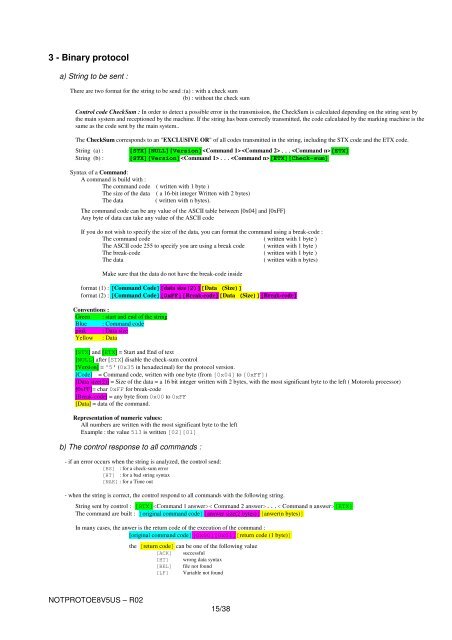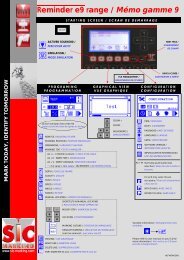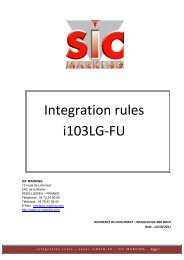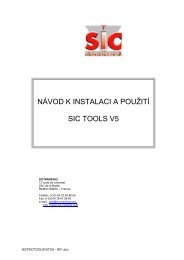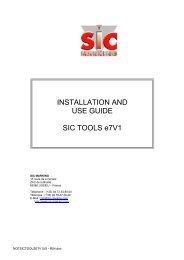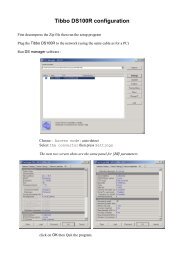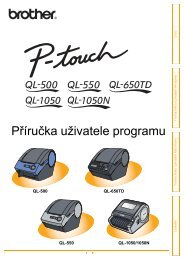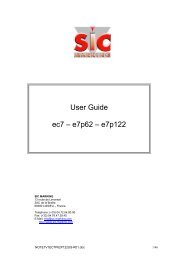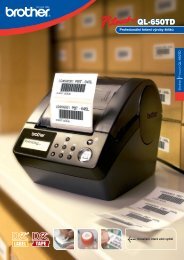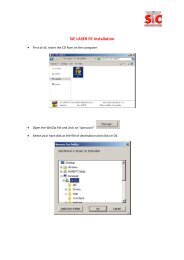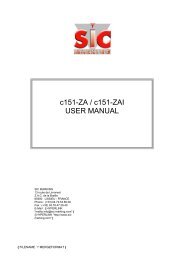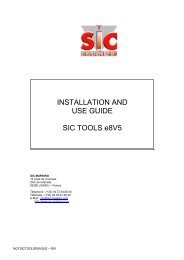COMMUNICATION PROTOCOL E8-V5 - SIC-Venim s.r.o.
COMMUNICATION PROTOCOL E8-V5 - SIC-Venim s.r.o.
COMMUNICATION PROTOCOL E8-V5 - SIC-Venim s.r.o.
Create successful ePaper yourself
Turn your PDF publications into a flip-book with our unique Google optimized e-Paper software.
3 - Binary protocol<br />
a) String to be sent :<br />
There are two format for the string to be send :(a) : with a check sum<br />
(b) : without the check sum<br />
Control code CheckSum : In order to detect a possible error in the transmission, the CheckSum is calculated depending on the string sent by<br />
the main system and receptioned by the machine. If the string has been correctly transmitted, the code calculated by the marking machine is the<br />
same as the code sent by the main system..<br />
The CheckSum corresponds to an "EXCLUSIVE OR" of all codes transmitted in the string, including the STX code and the ETX code.<br />
String (a) :<br />
String (b) :<br />
[STX][NULL][Version]...[ETX]<br />
[STX][Version]...[ETX][Check-sum]<br />
Syntax of a Command:<br />
A command is build with :<br />
The command code ( written with 1 byte )<br />
The size of the data ( a 16-bit integer Written with 2 bytes)<br />
The data<br />
( written with n bytes).<br />
The command code can be any value of the ASCII table between [0x04] and [0xFF]<br />
Any byte of data can take any value of the ASCII code<br />
If you do not wish to specify the size of the data, you can format the command using a break-code :<br />
The command code ( written with 1 byte )<br />
The ASCII code 255 to specify you are using a break code ( written with 1 byte )<br />
The break-code ( written with 1 byte )<br />
The data<br />
( written with n bytes)<br />
Make sure that the data do not have the break-code inside<br />
format (1) : [Command Code][data size(2)][Data (Size)]<br />
format (2) : [Command Code][0xFF][Break-code][Data (Size)][Break-code]<br />
Conventions :<br />
Green : start and end of the string<br />
Blue : Command code<br />
pink : Data size<br />
Yellow : Data<br />
[STX] and [ETX] = Start and End of text<br />
[NULL] after [STX] disable the check-sum control<br />
[Version] = '5' (0x35 in hexadecimal) for the protocol version.<br />
[Code] = Command code, written with one byte (from [0x04] to [0xFF])<br />
[Data size(2)] = Size of the data = a 16 bit integer written with 2 bytes, with the most significant byte to the left ( Motorola processor)<br />
[0xFF]= char 0xFF for break-code<br />
[Break-code] = any byte from 0x00 to 0xFF<br />
[Data] = data of the command.<br />
Representation of numeric values:<br />
All numbers are written with the most significant byte to the left<br />
Example : the value 513 is written [02][01]<br />
b) The control response to all commands :<br />
- if an error occurs when the string is analyzed, the control send:<br />
[BS] : for a check-sum error<br />
[HT] : for a bad string syntax<br />
[NAK] : for a Time out<br />
- when the string is correct, the control respond to all commands with the following string.<br />
String sent by control : [STX]< Command 2 answer>...< Command n answer>[ETX]<br />
The command are built : [original command code][answer size(2 bytes)][anwer(n bytes)]<br />
In many cases, the anwer is the return code of the execution of the command :<br />
[original command code][0x00][0x01][return code (1 byte)]<br />
the [return code] can be one of the following value<br />
[ACK] successful<br />
[HT] wrong data syntax<br />
[BEL] file not found<br />
[LF] Variable not found<br />
NOTPROTO<strong>E8</strong><strong>V5</strong>US – R02<br />
15/38


